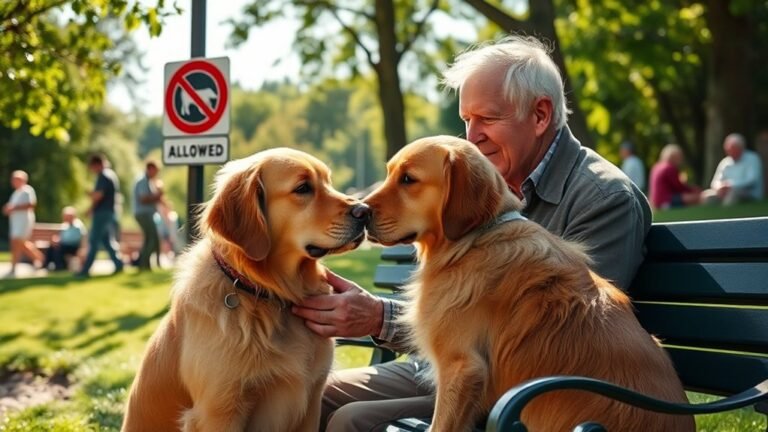8 Signs Your Dog Thinks They’re in Charge and How to Fix It
If your dog is barking a lot for attention or guarding their toys and food, they might think they are in charge. This can show a lack of clear leadership and rules at home. Noticing these signs is important because they can lead to problems in your relationship with your dog.
By spotting these behaviors, you can take steps to fix them. This will help you regain your role as the leader and create a happier and more balanced life for both you and your dog. You can enjoy your time together more when you have clear boundaries!
Key Takeaways
- If your dog barks a lot for attention, they might think they control their home. Try playing structured games with them to help focus their energy and reduce this behavior.
- When your dog takes the best spots in the house, it shows they may see themselves as the boss. Show them where they should rest by guiding them to specific areas to create a balanced home.
- If your dog doesn't listen to commands, it may feel powerful. Make your commands simple and use consistent rewards to help them understand and obey better.
- When your dog gets possessive over food and toys, it can mean they feel unsure or want to be in charge. Set up routines and use positive reinforcement to encourage sharing and relax their mind.
- If your dog doesn't want to share space, it can feel like they own the area. Make clear rules about personal space and reward calm behavior to help them learn to cooperate and trust you more.
Excessive Barking for Attention
When you come home after a long day, hearing your dog bark a lot for attention can be a bit much. This barking usually happens because your dog wants you to notice them. They may think that barking helps get your attention.
It's nice to play with your dog, but it's important to understand why they bark. Dogs love being around people, and they need interaction. If your dog learns that barking gets you to pay attention, they'll keep doing it.
Instead of giving into the barking, try redirecting their energy. You can play structured games or focus on training.
Be consistent. When your dog is quiet or behaves well, give them a reward. This helps create a calmer space for everyone in the home.
With patience, you can change this barking habit so that your dog feels safe and loved without all the noise.
Claiming Prime Spots in the House
If your dog barks for attention, they want to be noticed. But this behavior can also mean they think they control their space at home. A clear sign is when they take over your favorite spots, like the couch. When this happens, your dog might see themselves as the leader of the family.
To help create balance, guide your dog back to their special place. It's important to reward good behavior and redirect them when needed. This way, you set clear boundaries.
The goal is to make everyone feel safe and respected in your home, including your dog. Together, you and your dog can enjoy a happy living space.
Ignoring Commands and Instructions
Dogs can often ignore commands. This might show they think they've power. It can be frustrating, but this usually happens because of unclear commands or lack of consistency.
When your dog doesn't listen, take a moment to think about your training style. Ask yourself these questions: Are your commands easy to understand? Do you reward your dog when they do the right thing? Setting a routine and knowing what treats your dog likes can help them learn better.
Make your commands clear and stick to them. Use a firm but gentle voice to get your message across. Building trust and understanding with your dog is important. When your dog feels connected to you, they're more likely to listen.
Possessiveness Over Food and Toys
Dogs can get possessive over their food and toys. If your dog is guarding food or hoarding toys, it might be a sign they feel in charge. This behavior can come from fear or insecurity, and it can sometimes lead to aggression.
To help your dog feel safer, try to create a routine. Use positive reinforcement to teach them that being calm and sharing is good. Set up a special spot for feeding, and help your dog see you as a friend, not a threat.
You can also practice sharing. Start with treats and toys. Reward your dog when they share nicely. This will help them feel more relaxed and strengthen the bond between you.
In time, your dog will trust you more and feel less need to guard their things.
Refusing to Share Space
One sign that your dog thinks they're in charge is if they don't want to share their space. If your dog growls or snaps when you get close while they're resting, it means they feel like they own that spot. This can happen because they're used to protecting their area and may feel scared when you come near.
Sometimes, a dog that doesn't want to share will follow you around. They might be trying to show you they're in control.
To help with this, set clear rules about space. Encourage your dog to get used to you being nearby. You can reward them with treats and praise when they stay calm as you approach. This builds trust and helps both of you live together happily.
Jumping on Guests and Family
Many dogs get super excited when guests come over. They often jump on people because they think they're in charge of the house. This jumping happens when dogs greet people at the door. It can be cute, but it might overwhelm your visitors and make them uncomfortable.
To fix this, you can create a calm routine. When someone arrives, practice commands like "sit" or "stay." Give your dog a treat for staying calm and seated. This helps your dog learn that good behavior gets them attention and love.
By doing this, you teach your dog to respect space. At the same time, you make your home friendly and welcoming for guests.
Everyone can feel more at ease and enjoy their time together.
Lack of Respect for Personal Boundaries
When dogs invade your personal space too much, it can mean they don't respect your boundaries. This can make them think they're in charge at home. To help your dog understand their place, you need to set clear boundaries.
Here are some simple tips to teach your dog to respect your space:
- Make a special spot: Create a cozy area for your dog, like a bed or a mat, where they can feel safe and comfortable.
- Use clear commands: Teach your dog simple commands like "stay" or "back." This helps them learn when they need to give you space.
- Praise them: When your dog respects your space, give them lots of praise or a treat. This encourages them to keep doing it.
- Be consistent: Make sure to enforce the same rules every time. This will help your dog understand what's okay and what isn't.
With a little patience and training, you can build a friendly space where you and your dog feel respected.
Engaging in Aggressive Play Behavior
When your dog plays rough, it might mean they think they're in charge. This kind of play can include growling, biting, or just being too wild.
It's important to set some rules for playtime to keep everyone safe and happy. Make sure your dog knows when it's time to play and when to calm down.
Use toys to help redirect their energy away from aggressive actions. If your dog gets too intense while playing, take a break. Stop the game for a moment and then show them what's okay and what's not.
Frequently Asked Questions
How Can I Tell if My Dog Is Just Being Playful?
To see if your dog is being playful, watch their body language. Here are some signs to look for:
- Tail Wagging: A wagging tail usually means your dog is happy and ready to play.
- Relaxed Posture: If your dog looks relaxed and is not tense, they're likely feeling playful.
- Playful Barking: If your dog barks in a fun way, it shows they want to interact.
When your dog exhibits these behaviors, they are inviting you to join in the fun. Enjoy these moments together!
Is It Normal for Dogs to Test Boundaries Occasionally?
It's normal for dogs to test boundaries sometimes. They might want to see what they can get away with. You can help your dog learn what is okay by watching their behavior. Use simple training techniques to reward good behavior. This will make your dog feel safe and strengthen your bond as a pet owner. Just remember, patience and practice go a long way!
Can Certain Dog Breeds Be More Dominant Than Others?
Some dog breeds can show dominant behavior. This happens because of their natural traits and how they were bred. Knowing this can help you take care of your dog better. It's important to make your dog feel safe and valued in your home. When you understand your dog's nature, you can build a good relationship with them. Use this knowledge to meet your dog's needs and enjoy your time together.
How Does My Dog's Age Affect Their Behavior?
Your dog's age affects how they behave. Puppies are playful and full of energy. They love to run and explore. Older dogs, on the other hand, might slow down. They may not play as much and might prefer quiet time.
When you know how age changes their behavior, you can help your dog feel comfortable. For puppies, you can provide toys and activities to keep them busy. For senior dogs, you can create a calm space where they can relax.
Understanding your dog's age makes it easier to care for them. Each stage of their life comes with different needs and habits. Pay attention to these changes to support your furry friend.
Should I Seek Professional Help for a Dominant Dog?
Yes, it's a good idea to get professional help if your dog shows dominant behavior. A trainer can teach you effective ways to train your dog. This will help you build a positive relationship with your dog. You want your dog to be happy and well-adjusted, and a professional can guide you to achieve that.







